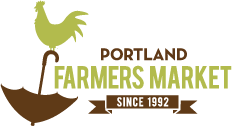Behind Burning Eyes
Article by Miriam Garcia
In the course of the year, there are a few special days when ordinary social rules are turned upside-down for a brief spell. On Halloween, for example, normally mild-mannered citizens roam the streets at night. They threaten respectable householders with mean tricks. They gorge on normally forbidden foods. And that’s just the kids. Halloween is what folklorists call a holiday of ‘misrule.’
As with most days of misrule (think Mardi Gras, New Year’s Eve, the Super Bowl), Halloween is truly a folk holiday. It is not sanctioned by any religion, state or other institutions, unless you count Hallmark and Hershey’s. It exists and persists simply because we want it to. Sort of like the Farmers Market, if you think about it.
There are other, even older, connections between Halloween and the Farmers Market and the farmlands that the market represents. At the very heart of the matter is the fact that Halloween is deeply rooted in the workings of the natural world. For the ancient Celts, October 31st was the most important day of the year. The holiday, which they called Samhain, was a major agricultural ‘marker,’ the date by which crops were to be harvested. And, as befits a time of dying light and dying vegetation, it was believed to be a night when the veil between our world and the underworld was lifted, so that the souls of the recently dead could cross over. Abundance and death together powered ancient Samhain, and the same two forces are still mixing it up in farm fields, orchards and forests, as well as in our Halloween traditions.
For example, consider your Jack O’ Lantern.
First, there’s the procurement of the pumpkin. For many people, this involves a pilgrimage from an urban area to a farm or to the Farmers Market. This is a symbolic return to nature in order to gather an emblem of the harvest; ye olde pumpkin.
Next, there’s the transformation of the pumpkin from a natural object (squash) into a spirit object (Jack O’Lantern). Like putting on a costume, turning a pumpkin into something else altogether seems to set the misrule into motion. It’s a way to step out of ordinary time.
Finally, there’s the big night… as we take on new personas in our costumes, our flickering lanterns assume other-worldly personas, too. The veil between the worlds does indeed seem thin as our symbols of the harvest and abundance, of death and mystery, of rule and misrule, all collide, slip sideways, and still, somehow, make sense.
At Samhain, the Celts lit bonfires, they feasted, they reveled, and they left gifts on their doorsteps to appease wandering spirits and tricksters. We may not live as close to nature as earlier generations, but at Halloween we feel the link to other times. We celebrate the turning of the season. We sense ancient truths burning in our Jack O’Lanterns’ eyes.
Miriam Garcia is a folklorist-foodie, freelance writer and guardian of a super-secret chicken soup recipe. You can contact her at Miriam_G@me.com
